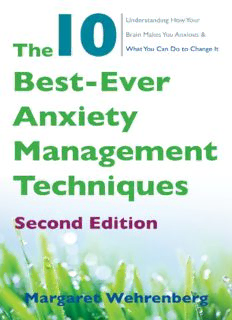
The 10 Best-Ever Anxiety Management Techniques PDF
Preview The 10 Best-Ever Anxiety Management Techniques
THE 10 BEST-EVER ANXIETY MANAGEMENT TECHNIQUES Understanding How Your Brain Makes You Anxious and What You Can Do to Change It SECOND EDITION MARGARET WEHRENBERG W. W. NORTON Independent Publishers since 1923 New York • London For Ellie and Hal Contents Preface PART I: UNDERSTANDING YOUR BRAIN ONE How Your Brain Makes You Anxious TWO Managing Your Brain With Medication PART II: MANAGING YOUR ANXIOUS BODY THREE Technique #1: Change Your Intake FOUR Technique #2: Breathe FIVE Technique #3: Practice Mindfulness SIX Technique #4: Rest and Relax PART III: MANAGING YOUR ANXIOUS MIND SEVEN Technique #5: Stop Catastrophizing EIGHT Technique #6: Stop Anxious Thoughts NINE Technique #7: Contain Your Worry PART IV: MANAGING YOUR ANXIOUS BEHAVIOR TEN Technique #8: Control TMA (Too Much Activity) ELEVEN Technique #9: Talk Yourself Into Changing Your Behavior TWELVE Technique #10: Implement a Plan and Practice the 3 C’s References Resources Acknowledgments Index The 10 Best-Ever Anxiety Management Techniques Preface Continuity gives us roots. Change gives us branches, letting us stretch and grow and reach new heights. —Pauline R. Kezer How does it happen that the 10 Best-Ever Anxiety Management Techniques need revision? If they were the best ever, then maybe they should remain the same. I believe, however, that Pauline Kezer got it right: there are times when change is necessary if we’re going to grow. As I teach the seminar based on this book, I am constantly changing and adapting it based on the latest neuroscientific research about how therapy works and how we can most effectively manage anxiety. This edition of the book reflects new information that makes anxiety easier to alleviate. In fact, all the methods I included in the first edition of this book are still included, but some have taken a backseat as other, more significant methods have been highlighted. Some tried-and-true methods are truer than ever before, as research has provided increasing support for how important they are. In many cases, I have clarified how to use the techniques, again based on the continuing stream of research about anxiety and its treatment. If you benefited from the first edition of this book, this revised edition will add to that. If you didn’t read the first edition, this is the resource that will help you to take charge of anxiety and get free from crippling panic, worry, or social anxiety. It is a blessing in my life to have this forum to share such life-altering knowledge. Margaret Wehrenberg March 2017 PART I UNDERSTANDING YOUR BRAIN When it comes right down to it, you can understand your brain only by using your brain. Every thought, image, and perception you have and every action you make begins with activity in your brain. And that’s good news, because—as this book is going to demonstrate—you can use your brain to change your anxious brain. And you can’t separate your brain activity from your body. If you think of your brain and body as distinct from each other, you set up a false dichotomy. Our brains are organs in our bodies, and every thought, image, and perception is linked to how it is affected and interpreted through sensory and visceral sensations. This brain–body interconnectedness is a major focus of this discussion about how your brain creates anxiety and can change anxiety. Now, you can manage anxiety effectively whether or not you know about the brain. You could skip Chapter 1 and use the rest of the book very well. The 10 techniques outlined in this book work, but their effectiveness doesn’t rely on understanding how they work. Nevertheless, an understanding of why these techniques are effective from a neurobiological standpoint can maximize how well they work. It will be easier for you to exert the effort needed to manage anxiety, even when it seems hard to do, if you know you’re changing your brain every time you control the symptoms. You automatically gain a certain measure of control over anxiety when you say to yourself, “This is my brain doing this. Anxiety is not me, and I can control it.” Chapter 1 is intended to give you enough brain basics to understand why these 10 techniques will work. MEDICATION CONTROLS THE BRAIN BUT DOESN’T TEACH TECHNIQUE It’s important to understand what medications do for anxiety and how they work so that when you make decisions about whether to add medication to anxiety management, you have clarity about the benefits and limits of drug therapy. What you may not have been told if you’ve started using meds for anxiety symptoms is that by relying solely on pills, you won’t learn how to control or eliminate your symptoms without medication. You’ll never develop the tools for managing the anxiety, which, in all likelihood, will turn up again whenever you feel undue stress or go through significant life changes. What you should be told when getting medication is that in many cases, the right management techniques can offer relief from anxiety in a matter of weeks—about the same amount of time it might take for anxiety medications to become effective. It is often best to have a therapist and a physician working with you to integrate an initial medication protocol with techniques you can use for effective anxiety management even after your meds are discontinued.
Description: